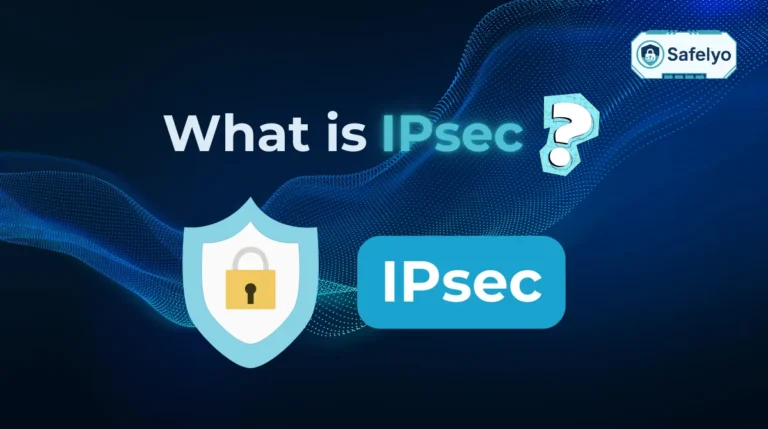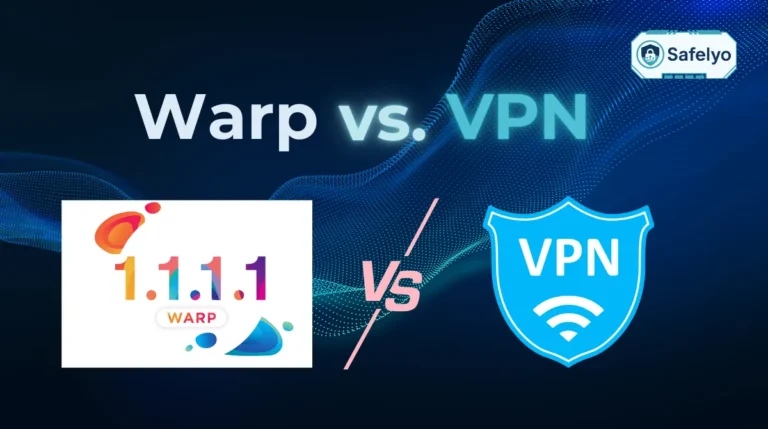Do you feel invisible just because you opened a private window? You might be asking if “is incognito mode private” really protects you. The answer is no. It cleans your local history, but your ISP, employer, and advertisers still see everything you do. This guide reveals the critical privacy gaps you must know to stay truly safe.
Key takeaways:
- Local only: It prevents your device from saving history but does not hide you from the internet.
- No encryption: Your ISP and network admin can still monitor your traffic.
- Visible identity: Logging into sites like Google or Facebook still tracks your activity.
- Real privacy: You need a VPN or specialized tools to achieve true anonymity.
1. TL;DR – Is incognito mode private?
No, incognito mode is not truly private. It only hides your activity from your local device by not saving browsing history, cookies, or form data. In other words, your browsing history won’t be stored locally, but that doesn’t mean websites forget what you’ve done. But it does not prevent your ISP, employer, school, or the websites you visit from tracking you.
Here’s what incognito mode really does and doesn’t do:
What it hides:
- Your browsing history from other users on your device.
- Saved cookies and site data after the session ends.
- Autofill data and search history on your browser. However, your search history may still be linked to online accounts if you stay logged in.
What it doesn’t hide:
- Your IP address
- Your identity if you’re logged into Google or other accounts
- Your online activity from your ISP, employer, or school network
- Tracking methods like browser fingerprinting
I once researched travel plans during work hours using incognito mode, thinking I’d avoid retargeted ads later. But I still saw price trackers and flight ads following me around. That’s when I realized incognito doesn’t hide everything, and certainly doesn’t make you invisible.
Next, let’s break down how incognito mode actually works.
2. What incognito mode actually does
At its core, incognito mode is designed for local privacy. If you’re wondering “how incognito works”, the answer lies in how browsers isolate your session from normal browsing activity. This isolation mainly affects your browsing history, ensuring visited sites don’t appear in your regular records. It’s useful for keeping certain browsing sessions from being saved on your device, but it does not make you anonymous online.
Here’s a breakdown of what incognito mode actually does:
2.1. Disables local browser history
When you’re in incognito mode, your browser doesn’t save the pages you visit to its history log. This means your browsing history won’t be stored locally, reducing traces left behind on your device. Once the window is closed, it’s like those pages were never opened – at least from your local perspective.
2.2. Automatically deletes cookies and site data
Cookies and cached files are stored temporarily but wiped as soon as you close your incognito session. This means websites won’t recognize you unless you’re logged in again.
2.3. Runs in a separate browsing session
Incognito creates an isolated browser session that doesn’t share cookies, login information, or site data with your regular browsing windows. This is especially useful for logging into multiple accounts on the same service – like two Gmail accounts – without interference.
2.4. Doesn’t sync to your Google or browser account
While using incognito, your activity won’t sync to your logged-in Google account or cloud-synced browser profile. This helps limit cross-device activity tracking – but only within the scope of the browser itself.
From my own experience, I often used Incognito to log into two Facebook accounts at once, one for work and one personal. It was great for convenience, but I always knew it wasn’t about anonymity. This can be helpful on shared devices, where you don’t want others seeing your activity later. Google still knew who I was the moment I logged in.
Incognito mode offers useful features for keeping your local browsing discreet. But to understand its limitations, we need to explore what it doesn’t hide. Let’s look at that next.
3. What incognito mode doesn’t hide
If you’re still wondering, “Is incognito mode private?” – this is where things get clear. While incognito hides your activity from other users on your device, it does not protect you from external tracking.
Many users mistakenly believe incognito mode hides their identity online. But in reality, it leaves key elements of your digital fingerprint exposed.
3.1. Your IP address is still visible
Websites, your internet service provider, and network providers can still see your IP address, which reveals your general location and internet provider. This is how content can still be geo-targeted or blocked.
3.2. Your activity can be seen by network admins
If you’re on a work, school, or public Wi-Fi network, the network administrator can monitor your online behavior, even in incognito. Everything you do still passes through their servers.
3.3. Logged-in accounts still track you
If you log into Google, Facebook, or any service while in incognito, your activity can still be tied to your account. That means your searches, likes, and browsing behavior may still be saved – just not to your local history.
3.4. Browser fingerprinting still works
Websites can use advanced techniques like browser fingerprinting to identify you based on your browser version, screen size, fonts, and extensions. Incognito doesn’t protect against this.
Here’s a quick overview of who can still see your activity in incognito mode:
| Entity | Can see activity in incognito? |
| ISP | Yes |
| Google (signed in) | Yes |
| Websites | Yes |
| Employer | Yes |
| Browser (locally) | No |
I remember searching for a health condition in incognito mode, thinking I was being discreet. But the next day, I saw YouTube ads and suggested articles that clearly reflected my search. That’s when I realized: incognito isn’t anonymous – and it certainly doesn’t hide you from trackers that operate outside your device.
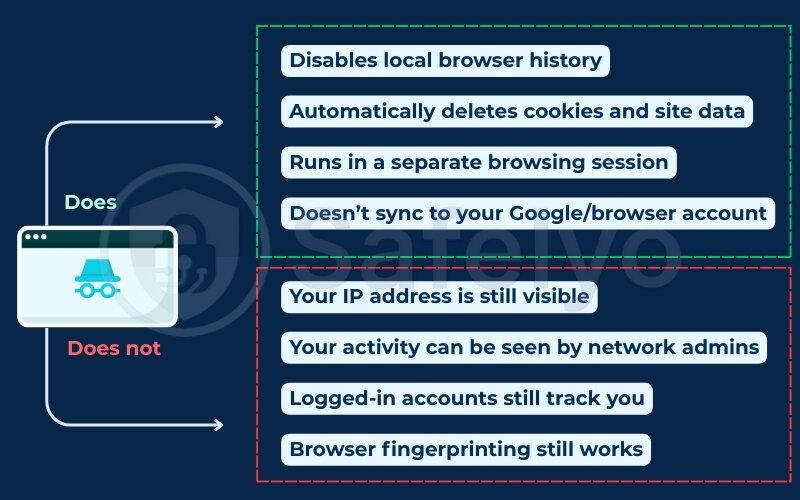
So why do so many people still use it? And what myths make incognito mode feel safer than it is? Let’s explore that next.
4. Why people use it and the myths that follow
Despite its limitations, millions of people use incognito mode daily. Why? Because it’s quick, convenient, and feels private – even if that privacy is mostly local. But this ease of access has also led to several common myths about what it actually protects.
4.1. Real reasons people use Incognito
People turn to incognito for a variety of practical and sometimes wishful reasons:
- Hiding NSFW or sensitive browsing from family or coworkers.
- Price shopping for flights or hotels, hoping to avoid dynamic pricing and get unbiased results.
- Bypassing paywalls on certain websites.
- Logging into multiple accounts on the same platform.
- Testing website behavior or debugging as developers.
In all of these scenarios, incognito mode offers local privacy, but not anonymity from networks, websites, or tracking services.
4.2. The biggest myths about incognito
Let’s address a few of the most persistent incognito myths:
- Myth: Incognito blocks ads.
Fact: It doesn’t. You’ll still see ads unless you’re running a separate ad blocker. - Myth: It hides your IP or location.
Fact: Your IP is still exposed to websites and networks. - Myth: You’re invisible to Google.
Fact: If you’re logged in, Google can still associate your activity with your account. - Myth: Incognito deletes everything.
Fact: It only prevents your device from saving browsing history, cookies, and form information. So while your browsing history looks clean on the device, online services may still log your actions.
I once assumed incognito mode would prevent websites from knowing who I was while researching a second-hand purchase on Facebook Marketplace. But after I messaged a seller, I still saw ads related to similar products for days. Clearly, login tracking and personalization still applied, even in private mode.
Next, let’s walk through how to actually activate incognito mode across popular browsers – and what you can expect from each one.
5. How to use incognito mode on all major browsers
Incognito mode is available on all modern web browsers, but the way you activate it and what it looks like can vary slightly. If you’re wondering how to open incognito mode in your browser of choice, this section walks you through it step-by-step.
Although using incognito mode is quick and easy, remember: is incognito mode private? Only locally. The session hides your activity from your device’s history, but not from networks or websites.
5.1. Quick access shortcuts for incognito mode
Here’s a handy table showing keyboard shortcuts to launch incognito mode on desktop:
| Browser | Shortcut (Windows) | Shortcut (Mac) |
|---|---|---|
| Chrome | Ctrl + Shift + N | ⌘ + Shift + N |
| Firefox | Ctrl + Shift + P | ⌘ + Shift + P |
| Edge | Ctrl + Shift + N | ⌘ + Shift + N |
| Safari | N/A | ⌘ + Shift + N |
| Brave | Ctrl + Shift + N | ⌘ + Shift + N |
| Opera | Ctrl + Shift + N | ⌘ + Shift + N |
5.2. Browser-specific instructions
Chrome (desktop & mobile):
- Desktop: Open the menu (three dots) → New Incognito Window
- Mobile: Tap the menu (⋮) → New Incognito Tab
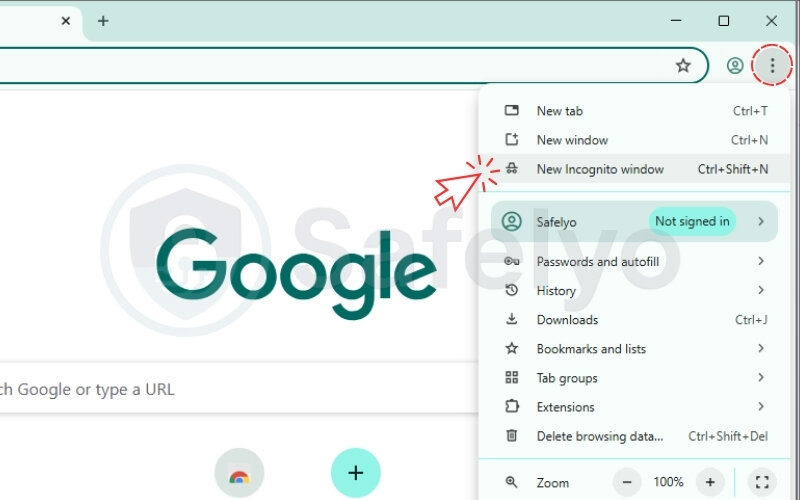
Safari:
- Desktop: File → New Private Window
- Mobile (iOS): Tap tabs icon → Tap Private → Tap +
Firefox:
- Desktop: Menu (☰) → New Private Window
- Mobile: Tap the tab icon → Tap the mask icon
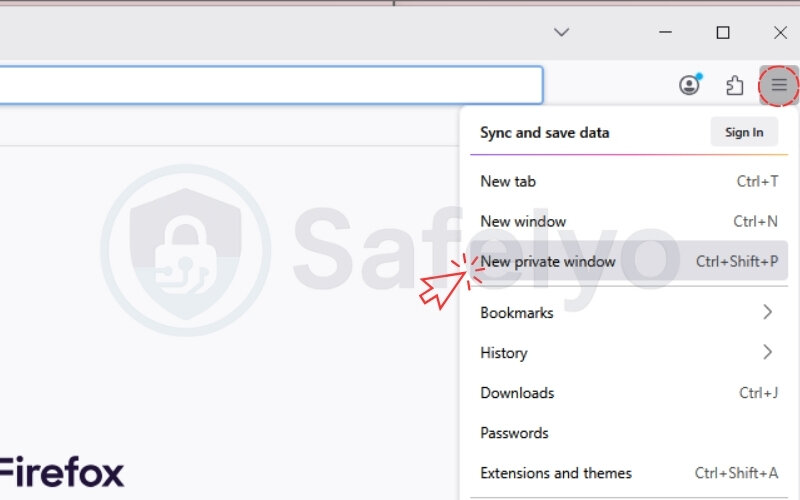
Microsoft Edge:
- Desktop: Menu (⋯) → New InPrivate Window
- Mobile: Tap menu (⋯) → New InPrivate tab
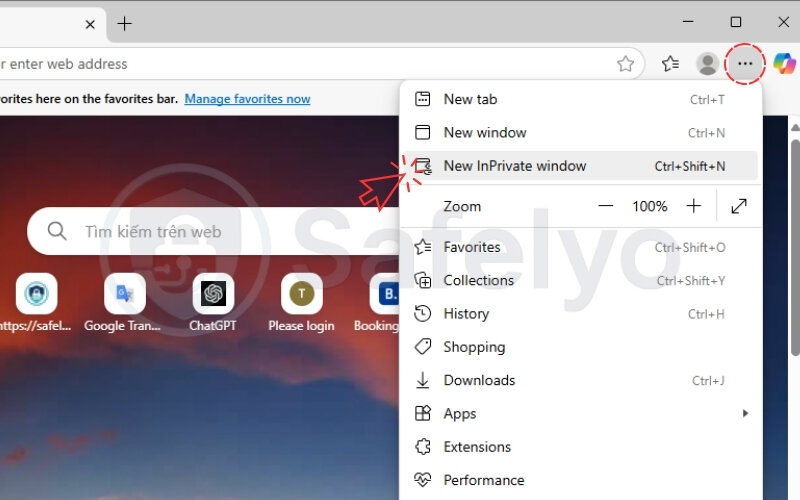
Brave:
- Menu (≡) → New Incognito Window
- For enhanced privacy, you can use Incognito with Tor (desktop only)
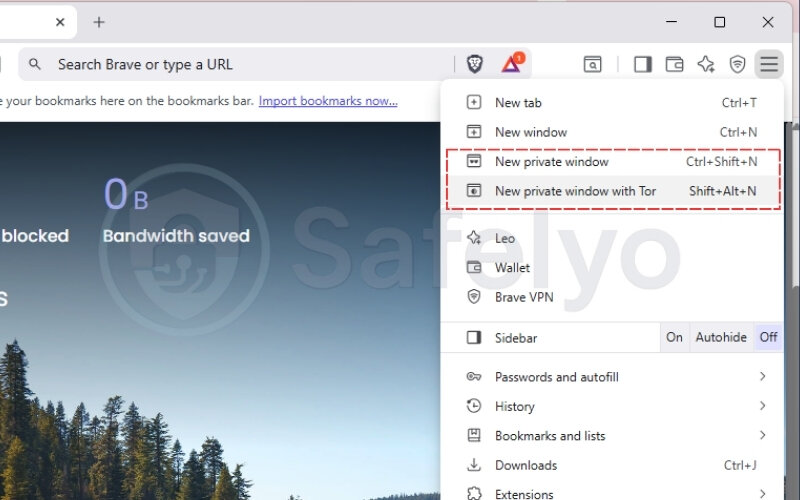
Opera:
- Menu (Logo on the left corner) → New Private Window
- Mobile: Tap tabs → Private mode
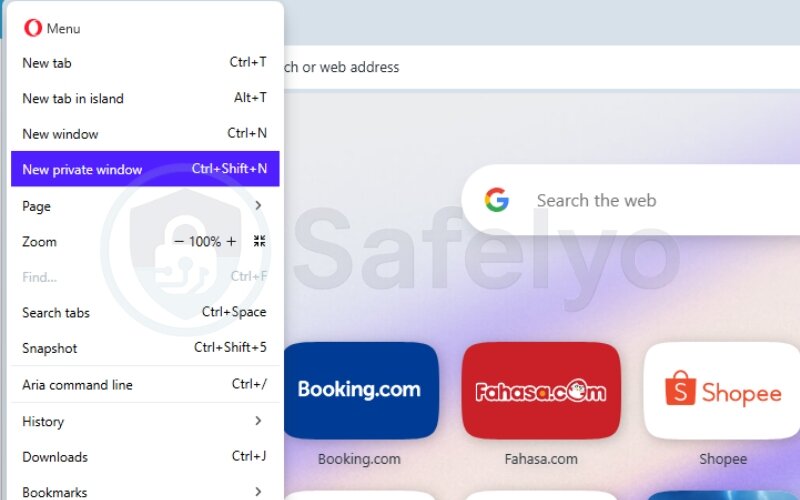
5.3. Comparing across platforms
I often research sensitive topics like legal rights or health questions across browsers. I’ve noticed Chrome and Brave make it easiest to open incognito tabs quickly, while Safari on iPhone requires a few more steps. On the desktop, Opera’s private browsing feels snappy, but Brave’s integration with Tor adds a small layer of extra privacy if needed.
Coming up next: we’ll explore how you can still be tracked in incognito mode – and what tools may help protect you better.
6. Can you still be tracked in incognito mode?
Yes, you absolutely can. Incognito mode creates a local sandbox for browsing, but it does not protect you from being tracked online. If you’re wondering, can I be tracked in incognito mode? The answer is yes, in several ways.
This section breaks down how websites, ISPs, and even your browser can still identify you during private sessions.
6.1. Common tracking methods that still work
Despite not saving local data, Incognito does not block:
- DNS leaks: Your system still queries websites via your ISP’s DNS, unless configured otherwise.
- Browser fingerprinting: Sites can identify you based on screen size, language, plugins, fonts, and more.
- Google account tracking: If you sign in to Google, your activity can still be recorded.
- Session correlation: Sites use IP addresses and behavioral patterns to tie anonymous and logged-in sessions together.
- Web beacons and cookies via third-party scripts: Some trackers reappear using fingerprinting or “evercookies”.
According to Norton Cybersecurity, “private browsing only hides your activity from others who use your device, not from your employer, ISP, or the websites you visit.”
6.2. Real-world example: being tracked anyway
I once researched freelance contract laws while logged into my Google account, thinking incognito mode would protect me. A few hours later, YouTube showed me related videos, and Gmail had ads for legal services. That’s when I realized: incognito doesn’t prevent tracking if you’re signed in or sharing your IP.
Even using different browsers doesn’t prevent fingerprinting. I tested Safari and Chrome side-by-side and still saw cross-site retargeting ads later, despite using private mode in both. Even switching browsing sessions across different browsers doesn’t guarantee anonymity.
If your goal is anonymity or full data protection, incognito alone won’t cut it.
In the next section, I’ll compare incognito mode with real privacy tools like VPNs, Tor, and proxies, so you can make informed choices.
7. Incognito mode vs. real privacy tools
If you’re serious about privacy, incognito mode is just a starting point. It’s useful for local session privacy, but not for true anonymity. So, how does it compare to tools like Tor and secure browsers?
Let’s explore how each option stacks up – and where incognito mode falls short in real-world protection.
7.1. Key differences between Incognito and other tools
Here’s a breakdown of what each privacy tool actually protects:
| Feature | Incognito Mode | VPN | Tor Browser | Proxy Server | Private Browser (e.g., Brave) |
|---|---|---|---|---|---|
| Hides local browsing history | Yes | Yes | Yes | Yes | Yes |
| Hides IP address | No | Yes | Yes | Yes | No |
| Encrypts internet traffic | No | Yes | Yes | No | Yes (Partial) |
| Prevents ISP tracking | No | Yes | Yes | No | No |
| Reduces browser fingerprinting | No | No | Yes (Partial) | No | Yes (Partial) |
| Prevents tracking by logged-in accounts | No | No | Yes | No | Yes (with limitations) |
| Provides true anonymity | No | No | Yes | No | No |
Incognito was never built for user anonymity, only for temporary local privacy.
Conclusion
Incognito mode is best for keeping your browsing private from others using your device. But if you’re asking is incognito mode is private in the context of your ISP, employer, or website tracking, the answer is no. You’ll need stronger tools.
7.2. Real testing experience
I once ran a side-by-side test booking flights:
- Incognito Mode: Helped avoid personalized prices, but ads still followed me later.
- VPN + Private Browser: Blocked tracking scripts, masked my IP, and showed better consistency in pricing.
- Tor: Offered true anonymity but was slow, too slow for time-sensitive deals.
From that, I realized that each tool has its role. For research or journalism, Tor makes sense. For daily browsing with better speed and moderate privacy, a VPN paired with a private browser is more practical.
Coming up: we’ll show you how to combine tools into a layered privacy setup for stronger protection in real-world scenarios.
8. How to build layered privacy online
Even though incognito mode provides basic local privacy, it’s far from enough to protect your identity or data across the web. If you’re serious about privacy, layering multiple tools is the most effective approach. This section shows how to go beyond just asking is incognito mode private, and start building real online privacy.
8.1. What layered privacy means
Layered privacy is the concept of combining several tools and techniques to cover different aspects of your online exposure. Instead of relying on one method, you use a stack of privacy protections that compensate for each other’s weaknesses.
8.2. Example privacy stacks
Below are a few practical privacy setups depending on your level of need:
1. Basic local privacy (casual users)
- Use incognito mode to avoid storing history or cookies.
- Add DuckDuckGo or Startpage as your search engine.
- Block trackers with uBlock Origin or Privacy Badger. You can also add browser extensions like Privacy Badger or HTTPS Everywhere for additional protection.
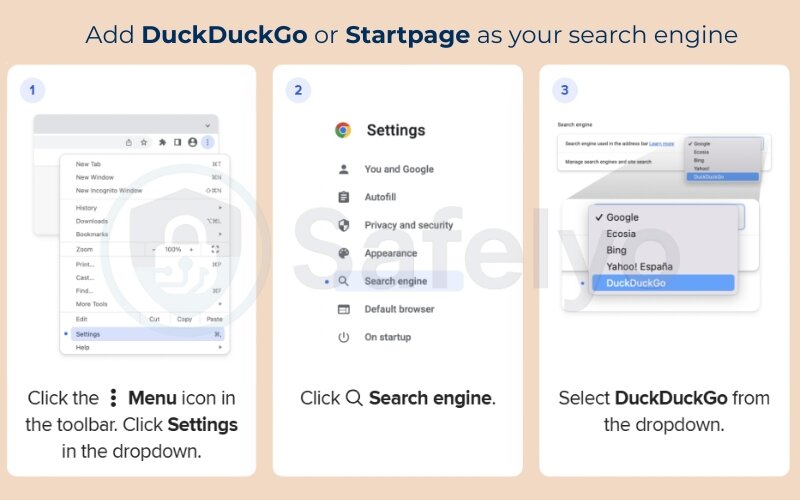
Note:
- DuckDuckGo is a privacy-focused search engine that doesn’t track your search history or profile you. It provides unbiased results and blocks hidden trackers automatically.
- Startpage offers Google search results with full privacy. It acts as an intermediary, keeping your personal data hidden from Google while still delivering high-quality results.
- uBlock Origin is a powerful, open-source browser extension for blocking ads and trackers. It’s lightweight, highly customizable, and helps speed up browsing while protecting your privacy.
- Privacy Badger, developed by the Electronic Frontier Foundation (EFF), automatically learns to block invisible trackers as you browse. It’s easy to use and adapts based on your browsing behavior.
2. Moderate privacy (daily protection)
- Always browse in Brave, Firefox with privacy add-ons, or Librewolf
- Use a virtual private network (e.g., ProtonVPN, Mullvad) for IP masking and encryption
- Enable DNS over HTTPS or DNSCrypt to prevent DNS leaks
- Use incognito mode for session isolation when switching accounts
3. High anonymity (journalists, researchers)
- Use the Tor Browser for identity masking
- Connect to a virtual private network before using Tor (VPN > Tor) for layered routing
- Avoid logging into personal accounts
- Use burner emails and pseudonyms
- Always use HTTPS-only mode
Each layer handles a specific privacy threat. For example, VPNs hide your IP, while Tor prevents profiling across sessions. Incognito alone doesn’t deliver these protections, but it can still play a role when combined strategically.
8.3. Personal setup example
My go-to privacy stack when traveling or working on sensitive research:
- Firefox with hardened settings
- Mullvad VPN with custom DNS
- Privacy Badger + HTTPS Everywhere
- Occasionally, use incognito mode to log into separate accounts without syncing
- Startpage as the default search engine
This setup isn’t perfect, but it balances convenience and privacy well for most of my daily needs. It also reduces the risks of malware infections during unsafe browsing. And it lowers the chance of falling victim to phishing attempts. This stack helps reduce exposure to cyber threats while keeping browsing lightweight. It also strengthens your overall online security, especially when traveling or using unsafe networks.
Next, let’s explore how private browsing and expectations of privacy are evolving in 2025 and beyond.
9. Private browsing in 2025 and the future of online privacy
The landscape of private browsing is rapidly changing. These shifts highlight how users now demand stronger guarantees from private browsing modes than ever before. The technology world is moving toward more advanced privacy frameworks, driven by legal pressure, browser innovation, and user demand.
9.1. New privacy initiatives
Some key developments shaping the future of browsing privacy include:
- Google Privacy Sandbox: Aims to replace third-party cookies with interest-based tracking. While touted as privacy-friendly, it still allows profiling based on behavior clusters.
- IP masking by default: Apple and Mozilla are experimenting with network relays and proxying IPs directly within the browser.
- Legal scrutiny: Google faced a $5 billion lawsuit in the U.S. over claims that incognito mode was misleading about privacy. These lawsuits are forcing browsers to clarify what “private” really means.
- Growth of private-first tools: Search engines like Kagi, Startpage, and DuckDuckGo are gaining traction by offering zero tracking. Some browsers now include simplified privacy settings that make it easier to manage trackers.
9.2. Changing user behavior
Over the past year, I’ve moved away from traditional browsers almost entirely. I now default to Brave for daily use and switch to Tor for anything sensitive. The shift wasn’t overnight – it came after realizing how exposed I still was, even in incognito mode.
The key takeaway? Privacy is becoming a mindset, not just a feature. Users in 2025 must think beyond browser modes and toward broader data hygiene.
Next, let’s tackle some of the most frequently asked questions about incognito mode and online privacy.
10. FAQs about is incognito mode private
This section answers the most common concerns around incognito mode and private browsing – all in simple, clear terms.
Can my employer see my incognito activity?
Yes. If you’re on a work or school network, your system administrator can see your browsing activity—even in incognito mode. Your browsing is not encrypted, and your IP is still visible.
Is incognito mode safe on public Wi-Fi?
Not entirely. While it hides your activity locally, it doesn’t encrypt your connection. Anyone on the same network (or the Wi-Fi provider) can potentially monitor your traffic. Use a VPN for added protection. But in reality, it leaves key elements of your digital footprint exposed.
Do VPNs make incognito private?
They help. A VPN hides your IP address and encrypts your traffic. When used with incognito mode, it improves your privacy, but logged-in services (like Google or Facebook) can still track you.
What’s the difference between incognito and private browsing?
None functionally. “Incognito” is Chrome’s branding. Other browsers call it “Private Window” or “Private Mode.” All work the same: local session data isn’t saved.
Can I be tracked in private browsing?
Yes. Websites can track you through browser fingerprinting, IP addresses, or logged-in accounts. Incognito does not block these methods.
11. Conclusion
So, is incognito mode private? The short answer: Only in a limited sense. It’s a useful tool for:
- Preventing local history from being saved
- Logging into multiple accounts
- Quick browsing without syncing
But it doesn’t:
- Hide your IP
- Encrypt traffic
- Block tracking by your ISP, employer, or logged-in platforms
If you want real privacy, incognito mode must be part of a larger setup. Combine it with a VPN, privacy-first browsers, and search engines that don’t track you.
Over the years, my own habits evolved from trusting incognito mode to building a full privacy stack. It started with curiosity, but became a necessity as I understood the scale of online surveillance.
Ready to level up your privacy? Check out our Privacy & Security Basics at Safelyo for tools, tips, and step-by-step guides.



